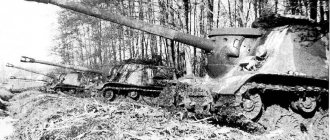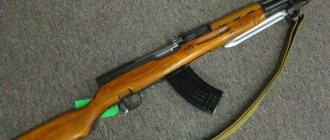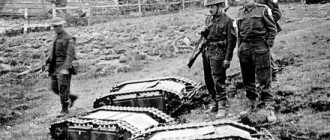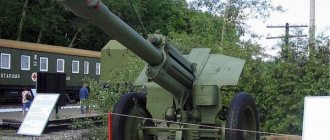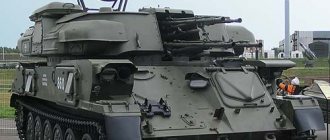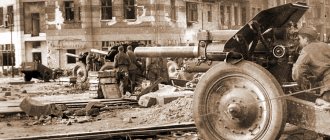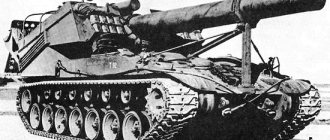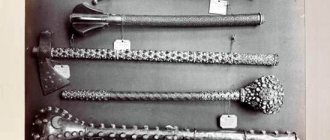SELF-PROPELLED 152-MM HOWITZER 2S3 “AKATSIA”
Weapons and Armament > Tanks > Self-propelled guns > Self-propelled 152-mm howitzer 2S3 "Akatsiya"
Just like the Gvozdika, the 152-mm Akatsiya self-propelled gun began to enter service with the Soviet Army in the early 70s. A special tracked chassis was used for the self-propelled unit. It also created such self-propelled guns as a 152-mm self-propelled gun, a 240-mm self-propelled mortar and a number of other combat and auxiliary vehicles. The development of the installation was carried out by the Transmash Central Design Bureau and the Ural Transport Engineering Plant in Sverdlovsk. The 2S3 Akatsiya self-propelled gun has three compartments: engine and transmission (front right), control (front left) and combat (rear). The body of the 2S3 Akatsiya vehicle is fully armored and provides protection for the crew from bullets and shrapnel. An anti-aircraft machine gun is installed on the commander's turret. There is a special hatch in the rear plate of the vehicle's hull for loading shells. In the stowed position, to avoid damage to the guidance mechanism, the howitzer barrel is locked on a special bracket. The self-propelled gun 2S3 "Akatsiya" is equipped with equipment for self-digging, which allows you to equip a trench for firing in 20-40 minutes. The 2A33 howitzer installed on this vehicle was equipped with a projectile and charge rammer into the gun chamber. The self-propelled guns were equipped with two mechanized racks for 46 rounds (one in the turret and one in the rear of the hull). The main firing mode that was envisaged was the supply of shells from the ground. In 1975, the self-propelled gun was modernized and received the 2S3M index. Instead of two mechanized mounts, one was introduced - a drum type, which made it possible to increase the ammunition load by 15 rounds. In 1987, the howitzer was improved again. It was equipped with equipment for receiving and displaying fire control information. This installation was named 2S3M1. In addition to the usual set of 152-mm shells, the howitzer’s ammunition load may also include special laser-guided “Krasnopol” and “Centimeter” shells. These projectiles have a guidance system based on the beam of a laser sight-illuminator reflected from the target.
CHARACTERISTIC
| TTX 2S3 | |
| Combat weight, t | 27,5 |
| Crew, people | 4 |
| Armament | 152 mm howitzer D-22 |
| Projectile weight, kg – high-explosive fragmentation | 43,56 |
| Projectile mass, kg - cumulative | 27,4 |
| Initial projectile speed, m/sec | 655 |
| Armor penetration of a cumulative projectile, mm | 250 |
| Maximum firing range, m | 17400 |
| Rate of fire, h/min | 4 |
| Ammunition, shots | 46 |
| Booking | Bulletproof |
| Engine type | diesel, 520 hp |
| Highway speed, km/h | 60 |
| Cruising range, km | 500 |
PHOTOS
| Photos of self-propelled guns 2S3 "Akatsiya" | |||
© KorAx™.
Appearance
In the Nokia lineup, classic (not side) sliders are quite rare. Therefore, it is not surprising that the design of the C2-03 resembles the features of some previous models, in particular the Nokia 7230.
The phone has smooth, rounded lines of the body, the design of the model is universal, suitable for a wide audience. Depending on the color design, users can determine their preferences: the device is presented in neutral black and a more striking white version.
The dimensions of the slider are rather large (the developers did not try to turn the device into a mini-backdrop), but at the same time comfortable. Compared to many other modern models, the C2-03 phone may seem a little thick. However, this is due to the form factor of the model.
The body is made entirely of plastic. I'm glad that mostly matte and non-slip material is used. It is pleasant to the touch and hides possible damage. The lower part of the body on both halves of the slider received a glossy insert (in the dark version it is chrome-plated, in the light version it is gold), which is already more susceptible to physical impact.
The touchphone is assembled with high quality, the body does not creak even under strong pressure. I was also pleased with the slider mechanism: the case doors are clearly fixed relative to each other and do not wobble in either the folded or open position. The automatic closing demonstrated correct operation - no significant effort is required to open the device.
Additional elements are placed as follows. On the right side there is a volume rocker and, just below, a lever for locking the touch screen. The left side of the case is occupied by the SIM 2 slot (the carriages for SIM 1 and microSD memory cards are located under the battery).
At the top end there is a 3.5 mm audio jack, a microUSB port and a connector for connecting a “thin” Nokia charger. There are no plugs for these elements.
On the back side there is a camera eye and a slot for the main speaker. The front side has only two physical keys under the display - start and end calls.
On the bottom flap of the slider there is a number-alphabetic block consisting of the usual 12 keys. Not as much space was allocated for them as we would like, so the buttons turned out to be narrow. At first this is unusual and causes discomfort when typing (we must not forget that this is actually the only full-fledged dialing method provided in the phone).
Luckily, there are small physical gaps between the rows of keys that allow you to feel your finger moving from button to button. The backlighting of the keys is uniform, milky in color. In general, despite the miniature size of the keyboard, once you get used to it, you can easily enter the necessary data with it.
Change of generations
Until the mid-sixties of the last century, self-propelled artillery units (SAU) from World War II, such as the SU-100, ISU-152 and ISU-122, continued to serve in the USSR Army. These vehicles combined the qualities of gun-howitzer systems with anti-tank capabilities. It was precisely for this versatility that they were liked by the old-school military, who had experience in combat operations during the Great Patriotic War. However, with the change of generations of officers and generals, new views on the tactics of using self-propelled artillery in modern warfare gradually formed.
So, in particular, the main enemy of tanks and other armored vehicles is not an ordinary projectile, but an anti-tank guided missile (ATGM). In this regard, military experts came to the conclusion that, on the one hand, self-propelled artillery mounts should not specialize in destroying heavy vehicles, and on the other hand, the new self-propelled guns should not be “dressed” in thick armor, because ATGMs can penetrate even the strongest of them . In addition, according to the new requirements, self-propelled artillery units must have maximum mobility, air transportability and increased buoyancy. In order for the equipment to meet these requirements, it was necessary to abandon heavy armor and give preference to bulletproof protection. As for the placement of the gun, to increase fire maneuver it should be placed not in an armored cabin, but in a freely rotating turret, which will allow the complex to conduct all-round fire. In addition, one of the main demands of the military was the creation of the ability to use nuclear weapons with updated self-propelled guns.
Dual SIM
The phone supports simultaneous operation of two SIMs, however, the presence of only one active radio module determines the following limitation: when talking on one of the SIMs, the other card will not be available.
The functionality of both cards is the same: with each you can make calls, send messages and connect to the Internet.
The SIM manager offers extensive settings for the operation of two cards. For example, you can define which module will be active for calls, messages or data transfers (a separate one can be selected for each of the parameters). Manually, the active map changes by holding the "*" button.
The implementation of Dual SIM in C2-03 is of high quality. During testing, no problems were noticed with voice transmission over SIM 2, which sometimes happens in inexpensive devices with two modules.
Perhaps the only thing that disappoints regarding the phone functionality of the model is the lack of support for 3G networks.
Design and ergonomics
Nokia C2-03 has a design familiar to Nokia fans. The slider with smooth angles and medium thinness makes a very pleasant impression. The thickness of the model is 17 mm; those who are used to thinner models will need time to get used to it. Nokia C2-03 is available in two colors – graphite black and white and gold. Despite the fact that the body is made of plastic (except for the aluminum back panel), the model looks solid. A mini-USB and a 3.5 mm mini-jack were placed on the top edge.
Another convenience is two slots for SIM cards, one located under the battery, and the second on the side. To replace or insert a second card, you do not need to remove the back cover or even turn off the phone. The buttons on the keyboard are large enough and comfortable. There's no joystick for navigation, but thanks to the touchscreen you won't need one. However, there is no virtual keyboard, and you can only enter text on a physical one.
Description of the machine
The artillery installation is made according to the classical scheme with a tower wheelhouse. The complex has an armored welded body, which is divided into three compartments: control, combat and power (motor and transmission). The first compartment is located between the engine bulkhead and the left side in the bow of the body. The driver's workplace is located here. The power compartment is located in the right front part. The transmission, engine, and power plant systems are located here. In the rear part of the hull there is a fighting compartment. At the bottom of the body there is a rotating platform, which is mounted on a ball chase; it rests on five rollers. The gunner's workplace is located to the left of the gun, and the loader's is to the right. The commander's seat is located behind the gunner.
The implementation of the self-propelled chassis differs from its predecessors in the use of small-link caterpillars with rubber-metal hinges and a front location of the drive rollers.
Combat use
The first serious conflict in which the Acacia self-propelled gun took part was the war in Afghanistan. In the 40th Army, 2S3 was the most common artillery mount. These self-propelled howitzers usually provided direct support to assault units. To protect against heavy-caliber DShK machine guns, the hull and turret of the self-propelled gun were hung with tracks or boxes of sand. Since 1984, 2S3 began to be used to escort convoys, which were often fired upon by the Mujahideen.
The Akatsiya self-propelled gun participated in almost all conflicts that arose on the territory of the USSR after its collapse. These units were used during the Transnistrian conflict, the Georgians used the Acacia during the war in Abkhazia, and this self-propelled unit was used by Russian troops in the first and second Chechen campaigns.
In 2008, Russian and Georgian troops used Akatsiya in Ossetia.
Currently, the 2S3 self-propelled gun is used by both warring parties in eastern Ukraine.
Currently, these self-propelled guns are actively used by the Syrian government army against the rebels.
Despite its very advanced age, “Acacia” continues to regularly perform military service not only in our country, but also abroad. The military loves this self-propelled gun for its simplicity and reliability. Most likely, she will remain in combat formation for a long time. As the experience of recent military conflicts shows, artillery will remain the “god of war” for a long time, and it is unlikely that it will be possible to find an equivalent replacement for it.
Power plants and auxiliary equipment
On the Akatsiya self-propelled howitzer, the developers installed a twelve-cylinder V-shaped four-stroke turbocharged liquid-cooled engine (B-59). Together with it, a mechanical double-flow transmission with planetary rotary mechanisms is used. The artillery mount is individually equipped with hydraulic telescopic shock absorbers. On the self-propelled guns, the designers installed special self-digging equipment, which allows them to dig a trench for shelter in the ground in twenty minutes. In order to heat the crew, a heating unit (OV-65G) was installed in the self-propelled gun, the productivity of which is 6500 kcal/hour. This self-propelled artillery complex has collective protection, equipped with PPO and PAZ systems, against weapons of mass destruction. 2S3 is equipped with an automatic fire system, a filter-ventilation unit, and a compartment sealing system, which made it possible to protect the crew from the effects of bacteriological, nuclear and chemical weapons. The self-propelled howitzer is sealed both during firing and during movement.
